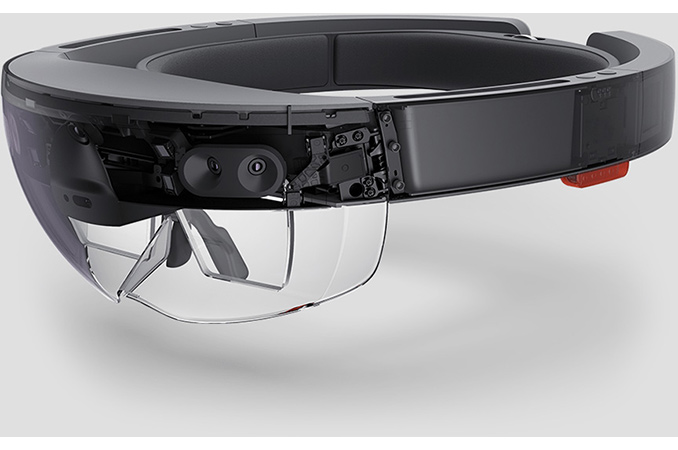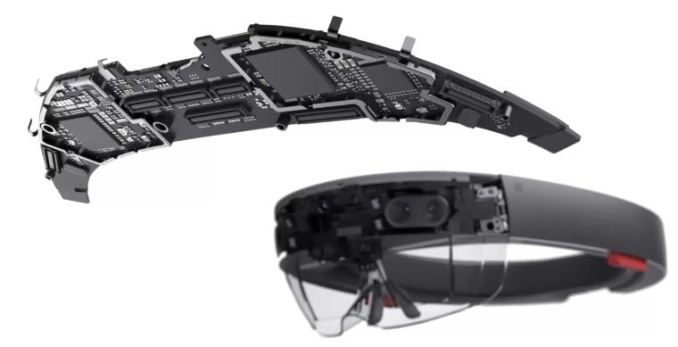Intel EOLs Atom Chip Used for Microsoft HoloLens
by Anton Shilov on August 10, 2017 1:00 PM EST- Posted in
- Gadgets
- CPUs
- Microsoft
- Windows 10
- Hololens
- Augemented Reality

Intel is retiring its Atom x5-Z8100P SoC that is used inside Microsoft’s HoloLens augmented reality headset. With the last units shipped in late October, it looks like the software giant is on track with its next-generation HoloLens that is due to arrive in the coming quarters.
Intel asks its customers to place their final orders on the Atom x5-Z8100P SoC (belonging to the Cherry Trail family) by September 30 and says that the final shipments will be made on October 30. Given the fact that Intel seems to have only one customer using the microprocessor, the short amount of time between the announcement of the product discontinuance and the actual EOL was probably negotiated before. Moreover, since we are talking about a semi-custom chip, Microsoft was probably the initiator of the EOL, which indicates that the company is on track with its next-gen HoloLens.
The current-generation Microsoft HoloLens wearable augmented reality PC was released in 2016 and is based on Intel’s Atom x5-Z8100P SoC as well as a custom-designed Microsoft holographic processing unit (HPU) that processes data from various sensors. The HoloLens is equipped with over a dozen of sensors, including a 2 MP video camera, an inertial measurement unit (which means, a set of accelerometers, gyroscopes and maybe even a magnetometer), one depth camera, four environment understanding cameras, four microphones, an ambient light sensor as well as mixed reality capture IC.
The next-generation Microsoft HoloLens will be different compared to the existing augmented reality platform, Microsoft revealed recently. While the device will run Windows 10 and will be equipped with an HPU, it will also feature an AI co-processor integrated into the latter that will use neural networks to enable object and voice recognition skills without the need for an Internet connection. The HPU 2.0 with the programmable AI co-processor will be a self-sufficient device that will run on battery power of the next HoloLens (hence, its power consumption will not be too high). The HPU 2.0 and the AI co-processor were designed entirely in-house and therefore are tailored for usage model of the HoloLens. Given the differences in architecture of the HoloLens Next compared to the existing model, it remains to be seen what kind of CPU Microsoft decides to use for it.
Microsoft demonstrated “an early spin of the second version of the HPU” running live code implementing hand segmentation at CVPR in late July. Therefore, while the chip is functional, it does not seem that the HoloLens Next is just around the corner and it is logical to expect it sometimes in 2018 or even in 2019.
Related Reading:
Source: Intel











17 Comments
View All Comments
name99 - Thursday, August 10, 2017 - link
You're making a whole lot of unjustified assumptions about why the CPU in the next Hololens with be Intel. ARM seems far more likely. The ARM makes it far easier for MS to order up a custom SoC that has EXACTLY what it wants on it --- as many CPUs as needed along with as many GPU cores are required, along with the AI coprocessor and HPU.And your statement "but development might be hard - because more stuff is done on x86 processors" reads like it's from the 1990s. Obviously MS has a full ARM development environment (which they used for Win RT, Win Mobile, and the current Win10 on ARM effort), and apart from that there are a variety of other ARM-aware development environments (like LLVM and GCC) which MS could incorporate into their tool chains. I don't know about GCC, but MS has been very aggressive in folding MS-specific technology (eg PE/COFF specifics, or how they handle exceptions) into LLVM.
I'd say you have your analysis completely backward. Atom was used for a few development units just because it was easiest, and it allowed MS to figure out what HW was really needed. Now that they know that, so they know just how much CPU and GPU they need, they know what functionality to stick in the HPU, etc, they can build their own bespoke (and likely ARM-powered) SoC.
romrunning - Friday, August 11, 2017 - link
@name99 - Maybe you have your interpretation wrong. Perhaps Microsoft started with Atom first because it was x86-compatible AND it was really low power.You're jumping to ARM, but you're disregarding decades of x86 experience. MS has spent far more time with it than with ARM. In fact, an ARM platform was an available choice from the beginning, but they chose a x86-compat proc instead. My logical guess was because of the processing power they needed (definitely greater than ARM), a power envelope they could handle, AND the years of experience they have w/x86.
So just as you accuse the OP of making "unjustified assumptions", don't do the same yourself. Fact is, all we have is conjecture (unless we're one of the decision makers who chose the CPU platform for MS).
HStewart - Friday, August 11, 2017 - link
@name99 - I making no assumptions at all - I just that with Microsoft long ( 3 decades ) experience with x86 that the Atom and it x86 code is a more logically choice and possibility ( read possibility ) that the Windows 10 on ARM is not living up what Microsoft is hoping."You're making a whole lot of unjustified assumptions about why the CPU in the next Hololens with be Intel. ARM seems far more likely. The ARM makes it far easier for MS to order up a custom SoC that has EXACTLY what it wants on it"
Like Microsoft has no experience in customizing x86 processors - even though it not from Intel, the AMD Jaguar CPU in the Xbox One is for one thing based of x86 that Intel first designed in 1980's.
Keep in mind Microsoft Surface (not pro) was original on Windows RT for ARM and how successful it was
I have not check out the Halo Lens - but for it to need an x86 processor instead of ARM, it got to have a lot of intelligence in that package.
Alexvrb - Sunday, August 13, 2017 - link
MS has plenty of experience with non-x86 processors. You're being silly. All their phones were ARM dating back to early single-core smartphone days. The Xbox 360 was PowerPC. They've had Windows running on uncommon architectures like DEC Alpha and Itanium. Windows is portable and they can work with ARM just fine. Recently they have ported full Windows 10 and it's APIs (as well as cut-down versions when computing resources are at a premium such as mobile devices) to ARM and they can natively compile to ARM. All their tools are architecture agnostic. There's no performance hit (unless you're executing x86 code on ARM, which the HoloLens would not be doing), there's no learning curve for them.With that being said, it COULD still be x86. But it's actually more likely to be ARM for one huge reason: Intel has NO current-gen quad-core Atom in the 2-3W range. They abandoned the ULP range. They still make new Atoms, for example "Apollo Lake" Goldmont based SoCs... but they're all LP, with quad cores closer to 10W.
Meanwhile you can get very low power ARM chips with 4+ high performance cores, or a big.LITTLE config. They're low-power and they're fast, with decent GPU options should you need it. If an off-the-shelf solution isn't good enough, I'm sure Sammy or QC would be happy to spin a semi-custom design.
serendip - Sunday, August 13, 2017 - link
ARM is the way forward for embedded stuff, especially for AR that needs a lot of sensor connectivity and low power. Microsoft has a ton of experience with non-x86 platforms and don't forget the up coming Snapdragon PCs that use Qualcomm ARM chips. Qualcomm also has VR and AR-specific chips so Microsoft might be going with those for the next HoloLens.HStewart - Friday, August 11, 2017 - link
"Intel asks its customers to place their final orders on the Atom x5-Z8100P SoC (belonging to the Cherry Trail family) by September 30 and says that the final shipments will be made on October 30"One thing II am curious about is this x5-8100P SoC - the chip is not listed on Intel's ARK site
http://ark.intel.com/products/series/87465/Intel-A...
the closes processor to it is the x5-E8000 which is an embedded Braswell
plus also none of the series is listed as end of life - so my thoughts on this are
1. This is a custom chip made in corporation with Microsoft and Intel
2. That this chip is only for development and newer chip is used for when HoloLens goes into production.
To me I feel like Atom was Intel's testing ground for making small system on chips and the technology they learn - as move into higher level cpu - include some of Core products
I am typing this on Intel Compute stick with m5-6y30 which is about as fast as my original Surface Pro - but this stick can fit in my pocket. ( no screen or keyboard of course )
1. that x5-Z
moiz - Tuesday, February 27, 2018 - link
Windows operating system practically provides a lame way to hide files and folders and that is not enough if you are serious about protecting your private data <a href="https://www.microsoft.com/en-us/store/p/folder-loc... lock</a>